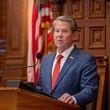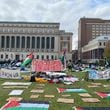Arlington, Texas population boom
1920: 3,331
1930: 3,661
1940: 4,240
1950: 7,692
1960: 44,775
1970: 90,643
1980: 160,113
1990: 261,721
2000: 332,969
2010: 365,438
2013 estimate: 379,577
Source: Census
Join the conversation! Have a question about the new Atlanta Falcons or Braves stadiums? Well, you can ask the AJC’s Dan Klepal and Tim Tucker during our online chat from 11:30 a.m. to 1 p.m. on Monday. Go to myajc.com/stadiumchat to post your questions or to share your thoughts about the cost of the stadiums.
Arlington, Texas — Robert Cluck was in his second year as mayor of this North Texas boom town in 2004, when he found opportunity in the pages of The Dallas Morning News.
The city had lured Major League Baseball decades earlier, when the Washington Senators relocated as the Texas Rangers in 1972, and began play at Turnpike Stadium. Then in the early ’90s, voters approved a sales tax increase to cover $135 million in debt for a new Rangers ballpark — a tax that paid those bonds off 10 years ahead of schedule, in 2002.
And now Cluck put his sights to a star as big as Texas itself — the Dallas Cowboys.
Cowboys’ owner Jerry Jones had negotiated a deal to build a $650 million stadium at Fair Park in Dallas, but the Dallas County Commission decided that summer to not place the $425 million tax on ballots. When Cluck read that, he knew Jones would be on the hunt for a new location.
And the mayor thought that his city — with about 380,000 people, situated squarely between the big shoulders of Dallas and Fort Worth — would be perfect.
“I called Jerry immediately — I went over that very day,” said Cluck, an obstetrician who is making a bid this year for his seventh two-year term. “It was supposed to be a $650 million stadium. I told him that if voters approve it … we’d pay half.”
They approved, 55-45, and the city's contribution bought a $1.3 billion stadium that has set new standards for cost, size, grandeur and versatility. In its first six years, AT&T Stadium has delivered a Super Bowl, a Final Four, a college football championship game and everything else from monster trucks to major concerts.
“It has been a big winner for Arlington,” Cluck said.
Cobb County is making a similar wager on the Braves as Arlington did on the Cowboys.
The county will borrow up to $397 million — albeit without a referendum — for stadium construction in hopes that it, and the Braves private mixed-use development, will generate additional tax revenue sufficient to provide a return on the investment.
As in Arlington, Atlanta’s decision to not hotly pursue the Braves led the team to leave.
The Atlanta Journal-Constitution has reported that the Braves started negotiating with Cobb County after expressing frustration that Atlanta Mayor Kasim Reed's administration was paying more attention to the Falcons deal, and were not making progress on the issue of development outside Turner Field.
Reed said the pressure is “enormous” when weighing a public investment against the possibility of losing an iconic sports team.
“The financial offer that was available in Cobb … was overwhelmingly persuasive,” Reed said. “We were never going to be in that range around the Braves. It was the difference between a Ford Explorer and a Range Rover.”
Still, Reed secured a Ferrari before the Braves signed on with Cobb.
The Falcons are building a new downtown stadium for $1.4 billion that appears ready to challenge the Cowboys in terms of opulence, space, and architectural beauty. Hotel-motel tax will pay for $200 million in construction, and approximately $400 million more for interest, operations and maintenance over 30 years.
Reed said it’s a great deal for the city.
“The hotel-motel tax was only extended to keep the Falcons on the George World Congress Center property,” Reed said. “If Falcons had gone away, we’d have lost $8-10 million. So one deal had a revenue stream; the Braves deal had no revenue stream.”
In Arlington, there were plenty of hard feelings on the way to opening the Cowboys stadium.
The city used eminent domain to take about 200 homes and businesses, clearing the way for the Cowboys’ luxury boxes and suites. It was the same tactic Arlington used years earlier, to clear land for the Rangers.
And the city issued $147 million in tax-free bonds on the Cowboys’ behalf, allowing Jones to save millions while using a surcharge on tickets and stadium parking to pay the debt.
Cluck credits Jones with never asking for more money, even after it became apparent that the stadium would blow past the billion-dollar mark.
“True to his word,” the mayor said.
About the Author







